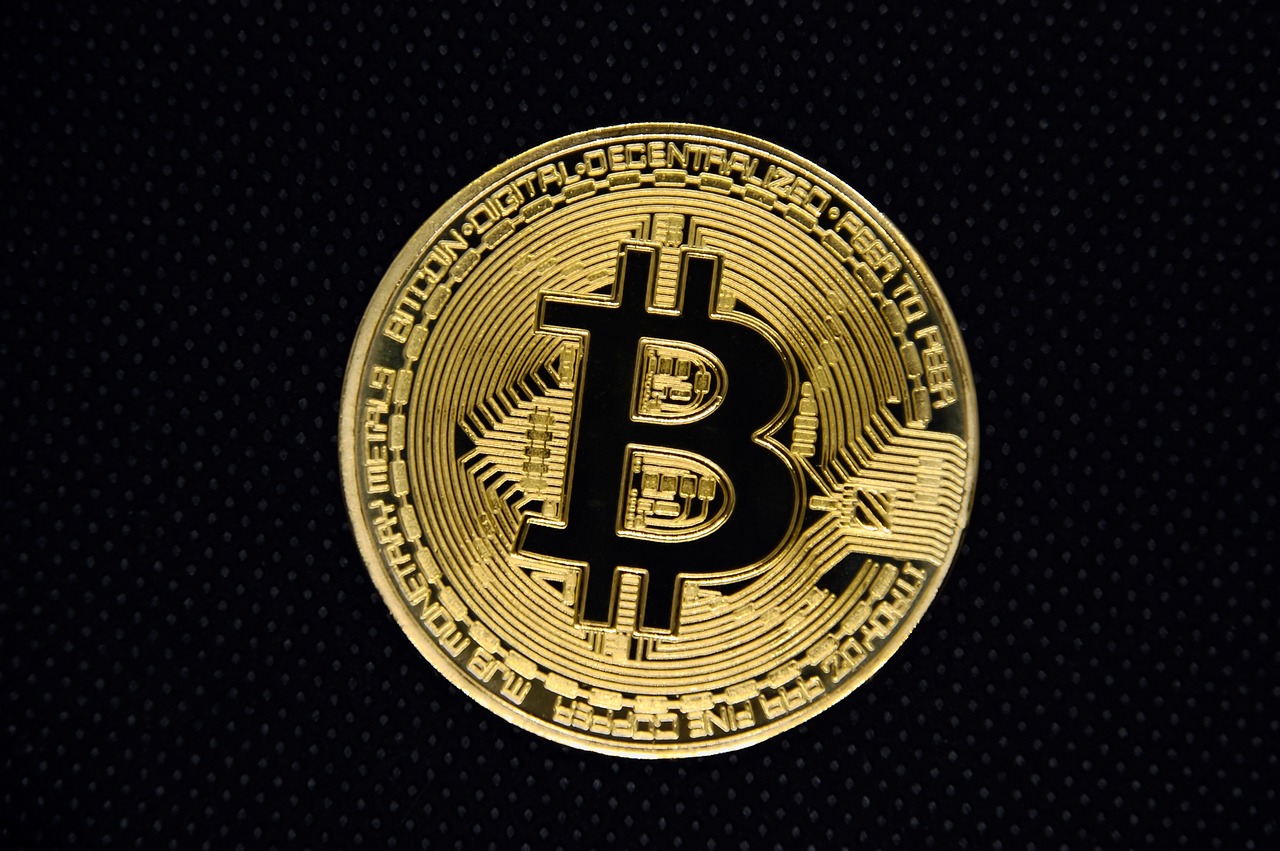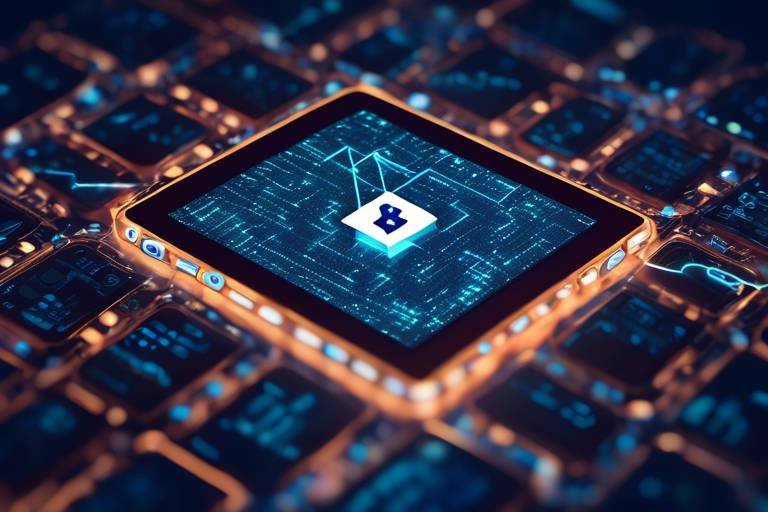The Role of Blockchain in Enhancing Cybersecurity
In today's digital landscape, where cyber threats loom large and data breaches make headlines, the need for robust cybersecurity measures has never been more pressing. Enter blockchain technology, a game changer that offers a decentralized approach to securing sensitive information. Imagine a world where data integrity is guaranteed, identity theft is a thing of the past, and threat detection is faster than ever. Sounds like a dream, right? Well, blockchain is turning that dream into a reality, and this article dives deep into how it enhances cybersecurity measures.
So, what exactly is blockchain? At its core, blockchain is a decentralized ledger technology that records transactions across multiple computers. This means that no single entity has control over the entire network, making it inherently secure. The beauty of blockchain lies in its three core principles: immutability, transparency, and security. Immutability ensures that once data is recorded, it cannot be changed or deleted, providing a reliable trail of information. Transparency allows all participants in the network to view the same data, fostering trust and accountability. Lastly, the security features of blockchain protect against unauthorized access, making it a formidable ally in the fight against cyber threats.
One of the standout features of blockchain is its decentralization. Unlike traditional systems that rely on a central server, blockchain distributes data across a network of computers. This drastically reduces the risk of a single point of failure, which is often the Achilles' heel of conventional cybersecurity measures. By spreading the data out, blockchain ensures that even if one node is compromised, the integrity of the entire network remains intact. This leads to enhanced data integrity, as it becomes exceedingly difficult for hackers to alter or breach the data without being detected.
Now, let's talk about immutability. In the context of cybersecurity, this means that once a record is added to the blockchain, it cannot be altered or deleted. This characteristic is crucial for maintaining accurate security logs. For instance, if a security incident occurs, the immutable nature of blockchain ensures that all details regarding the event are preserved. This not only aids in forensic investigations but also helps organizations comply with regulatory requirements. Imagine trying to piece together a puzzle where some pieces keep disappearing; that’s what traditional systems face when logs can be tampered with. Blockchain, however, keeps all pieces in place.
Another exciting aspect of blockchain technology is the use of smart contracts. These are self-executing contracts with the terms of the agreement directly written into code. Think of them as digital security guards that automatically enforce rules and regulations without human intervention. This automation reduces the likelihood of human error, which is often a significant factor in security breaches. When a threat is detected, smart contracts can trigger predefined responses, such as isolating affected systems or alerting administrators, all in real-time. This rapid response can be the difference between a minor incident and a full-blown crisis.
Identity theft is one of the most pervasive issues in cybersecurity today. Blockchain technology offers a solution by streamlining identity verification processes. By creating secure digital identities on the blockchain, individuals can manage their identities without relying on centralized databases prone to breaches. This decentralized approach not only enhances security but also empowers users by giving them control over their personal information. Imagine being able to prove your identity without handing over sensitive data to a third party; that's the power of blockchain.
Blockchain can also significantly enhance threat detection capabilities. By enabling real-time data sharing across networks, organizations can collaborate more effectively in identifying and responding to threats. Picture a neighborhood watch program where everyone communicates instantly about suspicious activities; that’s how blockchain operates in cybersecurity. With every participant in the network contributing to a collective understanding of potential threats, the response time is greatly reduced, making it easier to mitigate risks before they escalate.
Despite its many advantages, blockchain technology is not without its challenges. While it holds great promise for enhancing cybersecurity, several limitations could impede its widespread adoption. For instance, scalability issues present a significant hurdle. As more transactions are added to the blockchain, the speed of processing can slow down, leading to network congestion. This is particularly concerning for organizations that require quick access to data. Moreover, the regulatory landscape surrounding blockchain is still evolving. Compliance with existing laws and regulations can complicate the implementation of blockchain solutions in cybersecurity, as organizations must navigate a patchwork of legal requirements that vary by jurisdiction.
Scalability remains a significant challenge for blockchain networks. As the number of users and transactions grows, the technology must be able to handle increased demand without compromising performance. This can lead to slower transaction speeds and higher costs, which may deter organizations from fully embracing blockchain for cybersecurity applications.
The regulatory landscape for blockchain is still evolving. Compliance with laws and regulations can influence the implementation of blockchain solutions in cybersecurity. Organizations must stay informed about changes in legislation and ensure that their blockchain applications adhere to legal standards to avoid potential legal repercussions.
- What is blockchain technology? Blockchain is a decentralized ledger that records transactions across multiple computers, ensuring data integrity and security.
- How does blockchain enhance cybersecurity? By decentralizing data, ensuring immutability, and automating processes through smart contracts, blockchain significantly strengthens cybersecurity measures.
- What are smart contracts? Smart contracts are self-executing agreements with terms written into code, allowing for automated security responses.
- What challenges does blockchain face? Scalability issues and regulatory hurdles are two significant challenges that could affect the adoption of blockchain in cybersecurity.

Understanding Blockchain Technology
Blockchain technology is often described as a revolutionary force in the digital world, and for good reason. At its core, blockchain is a decentralized ledger that records transactions across a network of computers. This means that instead of having a single, central authority controlling the data, information is distributed across multiple nodes. This distribution not only enhances security but also ensures that the data remains transparent and accessible to all authorized users.
One of the most compelling aspects of blockchain is its immutability. Once a transaction is recorded on the blockchain, it cannot be altered or deleted. This feature is crucial for cybersecurity, as it creates a reliable and tamper-proof record of all activities. Imagine trying to change a page in a book that is locked in a glass case; that’s how difficult it is to alter blockchain records. This level of security is a game-changer for industries that require meticulous record-keeping, such as finance, healthcare, and supply chain management.
Another key principle of blockchain is transparency. Every participant in the network has access to the same version of the ledger, which fosters trust among users. This transparency can significantly reduce fraud and corruption, as any attempt to manipulate the data would be immediately visible to all parties involved. In a world where data breaches and cyberattacks are rampant, this feature offers a much-needed layer of protection.
Moreover, the security of blockchain is further enhanced through cryptography. Each block in the chain contains a unique cryptographic hash of the previous block, along with a timestamp and transaction data. This chaining of blocks makes it nearly impossible for hackers to alter any single block without changing all subsequent blocks, which would require an enormous amount of computational power. In essence, blockchain acts as a digital fortress, safeguarding data against unauthorized access and attacks.
To illustrate these concepts, let’s take a look at a simple table summarizing the core principles of blockchain technology:
| Core Principle | Description |
|---|---|
| Decentralization | Distributes control across multiple nodes, reducing single points of failure. |
| Immutability | Once recorded, data cannot be changed or deleted, ensuring integrity. |
| Transparency | All users have access to the same data, fostering trust and accountability. |
| Security | Utilizes cryptography to protect data and prevent unauthorized access. |
In summary, understanding blockchain technology is essential for grasping its potential impact on cybersecurity. Its decentralized nature, along with features like immutability, transparency, and robust security, makes it a formidable tool against the increasing threats in the digital landscape. As we delve deeper into the applications of blockchain in cybersecurity, it becomes clear that this technology is not just a trend, but a necessary evolution in how we protect our data.

Decentralization and Data Integrity
In the world of cybersecurity, decentralization is like having a safety net that stretches across a vast expanse, ensuring that if one part falters, the rest remains intact. Traditional systems often rely on a centralized model, where a single server or database holds all the data. This creates a single point of failure, making it easier for cybercriminals to exploit vulnerabilities. In contrast, blockchain technology distributes data across a network of computers, or nodes, making it incredibly difficult for an attacker to compromise the entire system.
Imagine a library where each book is not only stored on a shelf but is also replicated in hundreds of other libraries around the world. If someone attempts to alter a book in one library, the original copies in other locations remain untouched. This analogy captures the essence of how blockchain operates. Each transaction or piece of data is recorded in a block and linked to previous blocks, creating a chronological chain that is visible to all participants in the network. This transparency ensures that any unauthorized changes are immediately detectable, reinforcing the concept of data integrity.
Moreover, the decentralized nature of blockchain means that no single entity has control over the entire network. This collective ownership fosters a sense of accountability among participants. When everyone has access to the same information, it becomes significantly harder for any individual or group to manipulate data without being noticed. The result is a system where trust is built not on the reputation of a central authority but on the inherent design of the technology itself.
To illustrate the importance of decentralization in maintaining data integrity, consider the following table:
| Aspect | Centralized Systems | Decentralized Systems (Blockchain) |
|---|---|---|
| Data Control | Single entity controls data | Distributed control among all participants |
| Risk of Manipulation | High risk due to centralized access | Low risk; changes must be agreed upon by consensus |
| Transparency | Limited visibility; data hidden behind walls | Full visibility; all transactions are public |
| Data Recovery | Single point of failure; difficult recovery | Multiple copies; easy recovery from other nodes |
In summary, the decentralized architecture of blockchain not only enhances data integrity but also builds a more resilient cybersecurity framework. By distributing data across a network, blockchain minimizes the risks associated with traditional centralized systems. As we continue to explore the potential of blockchain in cybersecurity, it’s essential to recognize how this technology can redefine our approach to securing sensitive information.
- What is blockchain technology? Blockchain is a decentralized ledger that records transactions across multiple computers, ensuring transparency and security.
- How does decentralization enhance data integrity? Decentralization reduces the risk of a single point of failure, making it harder for unauthorized changes to go unnoticed.
- What are smart contracts? Smart contracts are self-executing agreements with the terms written into code, automating processes and minimizing human error.
- Are there challenges to implementing blockchain in cybersecurity? Yes, challenges include scalability issues, energy consumption, and evolving regulatory landscapes.

Immutability of Records
The concept of immutability in blockchain technology is one of its most compelling features, especially when it comes to enhancing cybersecurity measures. Imagine a diary that, once written in, cannot be edited or erased. This is essentially how blockchain operates. Each transaction or record added to the blockchain is permanent, creating a historical ledger that cannot be altered without consensus from the network. This characteristic is crucial for maintaining the integrity of security logs, as it ensures that once data is recorded, it remains unchanged and can be audited at any time.
In traditional systems, data can be modified or deleted, which poses significant risks. For instance, if a cybercriminal gains access to a server, they could easily alter logs to cover their tracks. However, with blockchain, even if someone attempts to tamper with data, the original record remains intact and visible to all participants in the network. This transparency acts as a deterrent against malicious activities, as any unauthorized changes can be quickly identified and addressed.
Furthermore, the immutability of records on the blockchain supports compliance with various regulations and standards that require accurate record-keeping. Organizations that handle sensitive data, such as financial institutions or healthcare providers, can benefit immensely from this feature. By leveraging blockchain technology, they can provide verifiable proof of data integrity, which is essential for audits and regulatory reviews.
To illustrate the importance of immutability, consider the following scenarios:
- Audit Trails: In the event of a security breach, organizations can refer back to the unaltered records stored on the blockchain to understand what happened and when.
- Data Provenance: In industries like supply chain management, blockchain can track the journey of products, ensuring that records of origin and ownership are immutable and trustworthy.
- Legal Evidence: Immutability can provide legally admissible evidence in court, as the records on the blockchain are time-stamped and unchangeable.
In conclusion, the immutability of records in blockchain technology not only enhances data security but also builds trust among users and stakeholders. As organizations continue to face growing cybersecurity threats, adopting blockchain for its immutable nature could be a game-changer in the fight against cybercrime.
- What is blockchain immutability? Blockchain immutability refers to the characteristic that records, once added to the blockchain, cannot be changed or deleted, ensuring data integrity.
- How does immutability enhance cybersecurity? It prevents unauthorized alterations to data, allowing for accurate security logs and audit trails that can be trusted.
- Can any data be stored immutably on the blockchain? Yes, any type of data can be recorded on the blockchain, making it suitable for various applications across different industries.

Smart Contracts for Automated Security
In the realm of cybersecurity, smart contracts are revolutionizing how we approach security protocols. Imagine a world where security measures are not just reactive but also proactive, where the systems themselves can execute necessary actions without human intervention. This is precisely what smart contracts bring to the table. These self-executing contracts, with the terms of the agreement directly written into code, eliminate the need for intermediaries and reduce the potential for human error.
One of the most compelling aspects of smart contracts is their ability to automate a variety of security processes. For instance, consider a scenario where a company needs to grant access to sensitive data. Traditionally, this would involve a lengthy verification process, often fraught with delays and the risk of unauthorized access. However, with smart contracts, access can be granted or revoked automatically based on predefined conditions. This not only speeds up the process but also enhances security by ensuring that access is tightly controlled and monitored.
Moreover, the transparency of blockchain technology means that every action taken by a smart contract is recorded on the blockchain. This creates an immutable audit trail that can be invaluable for compliance and forensic investigations. If a security breach occurs, organizations can trace back through the smart contract’s execution history to identify vulnerabilities and understand how the breach happened. This level of visibility is a game changer in the fight against cyber threats.
Let’s break down some of the key benefits of using smart contracts for automated security:
- Speed: Smart contracts execute instantly when conditions are met, significantly reducing response times to potential threats.
- Cost Efficiency: By removing intermediaries, organizations can save on operational costs associated with security management.
- Accuracy: Automated processes reduce the risk of human error, ensuring that security protocols are followed precisely as intended.
- Scalability: Smart contracts can be scaled to accommodate increasing security needs without compromising performance.
However, while smart contracts offer numerous advantages, they are not without challenges. The code must be meticulously written and tested to avoid vulnerabilities that could be exploited by cybercriminals. Additionally, organizations must ensure that all stakeholders understand the terms of the smart contracts to avoid disputes and confusion.
In conclusion, smart contracts represent a significant advancement in the field of cybersecurity. By automating security processes, they not only enhance the speed and accuracy of responses to threats but also provide a level of transparency that is crucial in today’s digital landscape. As organizations continue to navigate the complexities of cybersecurity, embracing smart contracts could very well be a pivotal step in fortifying their defenses.
Q1: What are smart contracts?
A smart contract is a self-executing contract where the terms of the agreement are written directly into code. It automatically enforces and executes the terms when predetermined conditions are met.
Q2: How do smart contracts enhance cybersecurity?
Smart contracts enhance cybersecurity by automating security protocols, reducing human error, and providing an immutable audit trail for all actions taken.
Q3: Are there any risks associated with smart contracts?
Yes, if the code is not properly written or tested, vulnerabilities can be exploited by cybercriminals. It’s essential to ensure that all smart contracts are thoroughly audited.
Q4: Can smart contracts be used in any industry?
While they are particularly beneficial in industries with high security needs, such as finance and healthcare, smart contracts can be adapted for use in various sectors.

Identity Verification through Blockchain
In today's digital age, identity theft has become a pervasive issue, affecting millions of people worldwide. Traditional identity verification methods often rely on centralized databases, making them vulnerable to breaches and fraud. However, blockchain technology offers a revolutionary approach to identity verification that enhances security and privacy. By leveraging the decentralized nature of blockchain, individuals can create and manage their digital identities in a way that minimizes risks and maximizes control.
Imagine a world where your identity is not stored in a single location, but rather distributed across a network of computers. This is precisely what blockchain enables. Each individual's identity can be represented by a unique cryptographic key, allowing them to prove their identity without revealing sensitive information. This method not only protects personal data but also empowers users to share it selectively, giving them greater control over who can access their information.
With blockchain, identity verification can be streamlined through the use of secure digital identities. These identities are created using a combination of biometric data, cryptographic keys, and other secure methods. When a person needs to verify their identity—whether for banking, online services, or government interactions—they can do so quickly and securely. This process eliminates the need for cumbersome paperwork and reduces the potential for human error.
Moreover, blockchain's inherent transparency ensures that all identity verifications are recorded in a tamper-proof manner. This means that once an identity is verified, the record cannot be altered or deleted, providing a reliable audit trail. Organizations can trust that the identities they are verifying are authentic, thereby reducing the risk of fraud. To illustrate, consider the following table that compares traditional identity verification methods with blockchain-based solutions:
| Feature | Traditional Methods | Blockchain-Based Methods |
|---|---|---|
| Centralization | Data stored in a single location | Data distributed across a network |
| Security | Vulnerable to breaches | Highly secure and tamper-proof |
| User Control | Limited control over personal data | Full control over data sharing |
| Verification Speed | Can be slow and cumbersome | Fast and efficient verification |
As we continue to embrace the digital landscape, the importance of secure identity verification cannot be overstated. Blockchain technology not only addresses the vulnerabilities present in traditional systems but also paves the way for a future where individuals can confidently manage their identities. With its ability to provide a more secure, efficient, and user-controlled method of identity verification, blockchain is undoubtedly a game-changer in the fight against identity theft.
- What is blockchain technology? Blockchain is a decentralized ledger technology that records transactions across multiple computers, ensuring security and transparency.
- How does blockchain enhance identity verification? By providing a decentralized and tamper-proof method for managing digital identities, allowing users to control their personal data.
- Can blockchain prevent identity theft? Yes, it minimizes risks associated with centralized databases and gives users greater control over their information.
- What are the benefits of using blockchain for identity verification? Enhanced security, user control, faster verification processes, and a reliable audit trail.

Threat Detection and Response
In today's digital landscape, where cyber threats are as common as the air we breathe, the ability to detect and respond to these threats swiftly is crucial. This is where blockchain technology comes into play, offering a robust framework for enhancing threat detection and response mechanisms. Imagine a world where every transaction and interaction is recorded on an immutable ledger, accessible to all but alterable by none. This is the promise of blockchain—a decentralized network that provides real-time data sharing across multiple nodes.
When it comes to threat detection, the traditional systems often operate in silos, leading to delayed responses and increased vulnerabilities. Blockchain, on the other hand, fosters a collaborative environment where information can be shared instantly across various stakeholders. By utilizing a distributed ledger, organizations can have a comprehensive view of their security landscape, enabling quicker identification of anomalies and potential threats. For instance, if one node detects unusual activity, it can alert others in the network without the need for a central authority, significantly reducing the time it takes to respond to potential breaches.
Moreover, the transparency inherent in blockchain technology allows for greater accountability. Every action taken within the network is recorded, creating a clear trail that can be audited. This not only helps in identifying the source of a threat but also in understanding how it evolved, which is invaluable for improving future security measures. In fact, organizations can utilize smart contracts to automate responses to detected threats, ensuring that predefined actions are executed without human intervention. This reduces the risk of human error and ensures a swift reaction to incidents, effectively minimizing potential damage.
However, it’s essential to acknowledge that while blockchain enhances threat detection and response, it is not a silver bullet. Organizations must still employ a multi-layered security strategy that includes traditional cybersecurity measures alongside blockchain solutions. By integrating these technologies, businesses can create a more resilient defense against cyber threats. To illustrate this integration, consider the following table that outlines how blockchain complements existing cybersecurity frameworks:
| Traditional Security Measures | Blockchain Enhancements |
|---|---|
| Centralized data storage | Decentralized ledger for data integrity |
| Single point of failure | Distributed network reduces vulnerabilities |
| Delayed threat detection | Real-time data sharing across nodes |
| Manual incident response | Automated responses via smart contracts |
In conclusion, the integration of blockchain technology into cybersecurity frameworks offers a promising avenue for enhancing threat detection and response capabilities. By leveraging its decentralized nature, organizations can improve their situational awareness, streamline incident responses, and ultimately fortify their defenses against ever-evolving cyber threats.
- What is blockchain technology? Blockchain is a decentralized ledger that records transactions across multiple computers, ensuring transparency and security.
- How does blockchain enhance threat detection? It allows for real-time data sharing across a network, enabling quicker identification and response to potential threats.
- What are smart contracts? Smart contracts are self-executing agreements with the terms directly written into code, automating processes and reducing human error.
- Are there any limitations to using blockchain for cybersecurity? Yes, challenges such as scalability, energy consumption, and regulatory issues can impact its adoption.

Challenges and Limitations of Blockchain
While blockchain technology comes with a plethora of advantages that can significantly enhance cybersecurity, it is not without its challenges and limitations. Understanding these hurdles is crucial for organizations considering the adoption of blockchain solutions. One of the primary concerns is scalability. As more transactions are added to the blockchain, the speed at which these transactions are processed can slow down, leading to potential bottlenecks. Imagine a highway that becomes congested during rush hour; similarly, blockchain networks can experience delays when they are overwhelmed with traffic.
Another significant challenge is energy consumption. The process of validating transactions on blockchain networks, especially those that use proof-of-work mechanisms, can require substantial computational power. This leads to high energy consumption, raising concerns about the environmental impact. For instance, Bitcoin mining has been criticized for its carbon footprint, which can deter organizations from adopting blockchain technology for cybersecurity purposes.
Moreover, regulatory considerations play a crucial role in the implementation of blockchain solutions. The legal landscape surrounding blockchain is still evolving, and organizations must navigate a complex web of regulations. Compliance with laws related to data privacy, security, and financial transactions can be daunting. For example, the General Data Protection Regulation (GDPR) in Europe poses challenges for blockchain's immutable nature, as it requires the ability to delete personal data upon request.
In addition to these challenges, there are also concerns regarding interoperability. Different blockchain platforms may not be compatible with one another, which can hinder the seamless exchange of data across networks. This lack of standardization can create silos, reducing the effectiveness of collaborative cybersecurity efforts. To illustrate, if one organization uses Ethereum while another relies on Hyperledger, they may face difficulties in sharing vital security information.
Despite these challenges, it is essential to recognize that many organizations are actively working to address these limitations. For instance, advancements in blockchain technology, such as the development of layer 2 solutions and more energy-efficient consensus mechanisms, are paving the way for broader adoption. As the technology matures, it is likely that many of these challenges will be mitigated, allowing blockchain to play an even more significant role in enhancing cybersecurity.
- What are the primary challenges of blockchain technology? The main challenges include scalability, energy consumption, regulatory considerations, and interoperability.
- How does scalability affect blockchain's effectiveness? Scalability issues can lead to slower transaction processing times, especially during peak usage, which can hinder its application in real-time cybersecurity scenarios.
- Are there any solutions being developed to address these challenges? Yes, advancements such as layer 2 solutions and energy-efficient consensus mechanisms are being explored to improve blockchain scalability and reduce energy consumption.
- How do regulatory considerations impact blockchain adoption? Organizations must comply with evolving regulations, which can complicate the implementation of blockchain solutions, particularly in areas like data privacy.

Scalability Issues
When we talk about blockchain technology, one of the first things that come to mind is its potential to revolutionize various sectors, including cybersecurity. However, as promising as it may be, scalability remains a significant challenge that cannot be overlooked. Imagine trying to fit a large puzzle into a tiny box—this is akin to the struggle blockchain faces when it comes to handling a high volume of transactions simultaneously. The current architecture of many blockchain networks is not designed to process large amounts of data quickly, which can lead to congestion and delays.
To put it in perspective, let's consider the transaction speeds of some popular blockchain networks. For instance, Bitcoin can handle approximately 7 transactions per second, while Ethereum processes around 30 transactions per second. In contrast, traditional payment networks like Visa can manage over 24,000 transactions per second. This stark difference highlights the scalability issues that blockchain must address to compete effectively in the cybersecurity realm.
| Network | Transactions per Second |
|---|---|
| Bitcoin | 7 |
| Ethereum | 30 |
| Visa | 24,000+ |
Moreover, the increasing number of users and applications relying on blockchain technology exacerbates the problem. As more devices connect to the network, the demand for faster processing speeds grows, leading to potential bottlenecks. This can result in longer wait times for transactions to be confirmed, which is particularly concerning in cybersecurity, where timely responses are crucial for thwarting threats.
Another aspect of scalability issues is the energy consumption associated with maintaining blockchain networks. The process of validating transactions and securing the network often requires substantial computational power, leading to increased energy usage. This not only raises operational costs but also poses environmental concerns, as many blockchain networks rely on energy-intensive consensus mechanisms like Proof of Work.
To tackle these scalability challenges, various solutions are being explored, such as layer 2 solutions and sharding. Layer 2 solutions, like the Lightning Network for Bitcoin, aim to facilitate off-chain transactions, which can significantly reduce the load on the main blockchain. Sharding, on the other hand, involves splitting the blockchain into smaller pieces (or shards) that can process transactions simultaneously, enhancing overall efficiency.
In conclusion, while blockchain technology offers a promising approach to enhancing cybersecurity, its scalability issues pose a significant hurdle that must be addressed. As the technology continues to evolve, finding effective solutions to these challenges will be crucial for its widespread adoption and success in the cybersecurity landscape.
- What is blockchain scalability?
Blockchain scalability refers to the capability of a blockchain network to handle an increasing amount of transactions efficiently without compromising performance. - Why is scalability important in cybersecurity?
Scalability is critical in cybersecurity because timely processing of transactions can be essential for detecting and responding to security threats effectively. - What are some solutions to blockchain scalability issues?
Solutions include layer 2 technologies, sharding, and alternative consensus mechanisms that require less computational power.

Regulatory Considerations
When it comes to the adoption of blockchain technology in cybersecurity, one cannot overlook the myriad of that come into play. As blockchain continues to evolve, the regulatory landscape is also shifting, creating a complex environment for businesses looking to implement these innovative solutions. The challenge lies in navigating through various laws and regulations that can significantly impact the deployment of blockchain systems.
One of the primary concerns is compliance with data protection regulations, particularly those that govern the handling of personal information. For instance, regulations such as the General Data Protection Regulation (GDPR) in Europe impose strict guidelines on how personal data should be collected, processed, and stored. Blockchain's inherent characteristics, such as immutability and decentralization, can sometimes conflict with these regulations, especially when it comes to the right to be forgotten. This creates a dilemma for organizations that wish to leverage blockchain for enhanced security while remaining compliant with existing laws.
Moreover, regulatory bodies are still trying to understand the implications of blockchain technology fully. This uncertainty can lead to a lack of clear guidelines, making it difficult for businesses to plan their blockchain initiatives. Companies may find themselves in a position where they must adapt their strategies to align with evolving regulations, which can be both time-consuming and costly.
Another significant aspect is the need for cross-border compliance. Since blockchain networks are inherently global, organizations must consider the regulatory frameworks of different jurisdictions. This can lead to a confusing patchwork of regulations that vary from one region to another, complicating the implementation of blockchain solutions. To address these challenges, organizations may need to invest in legal expertise to ensure that their blockchain initiatives comply with all applicable laws.
In summary, while the potential of blockchain in enhancing cybersecurity is enormous, navigating the regulatory landscape is fraught with challenges. Companies must remain vigilant and proactive in understanding the evolving regulations that govern blockchain technology. This not only ensures compliance but also fosters trust among users and stakeholders, ultimately paving the way for broader adoption of blockchain solutions in the cybersecurity realm.
- What are the main regulatory challenges for blockchain technology?
The main challenges include compliance with data protection laws, navigating cross-border regulations, and adapting to evolving legal frameworks. - How does blockchain technology conflict with data protection regulations?
Blockchain's immutability can conflict with regulations like GDPR, which grants individuals the right to have their data erased. - Why is cross-border compliance important for blockchain?
Since blockchain operates globally, organizations must adhere to various international regulations, which can complicate implementation.
Frequently Asked Questions
- What is blockchain technology?
Blockchain technology is a decentralized ledger system that records transactions across multiple computers. Its core principles include immutability, transparency, and security, which make it a powerful tool for enhancing cybersecurity.
- How does blockchain enhance data integrity?
By decentralizing data storage, blockchain reduces the risk of a single point of failure. This means that data is less susceptible to unauthorized alterations or breaches, ensuring that the information remains accurate and trustworthy.
- What does immutability mean in the context of blockchain?
Immutability refers to the characteristic of blockchain that prevents any changes or deletions to recorded data. This is crucial for maintaining accurate security logs, as it ensures that once data is entered, it cannot be tampered with.
- How do smart contracts work?
Smart contracts are self-executing agreements with the terms written directly into code. They automate security protocols, reducing the chance of human error and speeding up responses to potential threats.
- Can blockchain improve identity verification?
Absolutely! Blockchain can streamline identity verification processes, significantly reducing the risk of identity theft. It allows for the creation and management of secure digital identities, making verification easier and more reliable.
- How does blockchain assist in threat detection?
Blockchain enhances threat detection by enabling real-time data sharing across networks. This collaborative approach allows organizations to identify and respond to threats more effectively, improving overall cybersecurity measures.
- What are some challenges facing blockchain in cybersecurity?
While blockchain offers many advantages, it also faces challenges like scalability issues, energy consumption, and regulatory hurdles. These factors can impact its widespread adoption in cybersecurity solutions.
- What scalability issues does blockchain face?
Scalability is a significant challenge for blockchain networks, as transaction speed and network congestion can hinder its effectiveness in large-scale cybersecurity applications. Solutions are being explored to address these limitations.
- Are there regulatory considerations for blockchain?
Yes, the regulatory landscape for blockchain is still evolving. Compliance with existing laws and regulations can greatly influence the implementation of blockchain solutions in cybersecurity, requiring organizations to stay informed and adaptable.



















